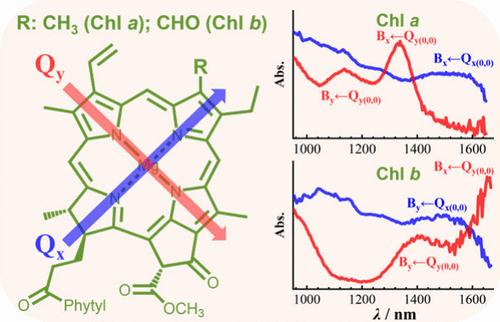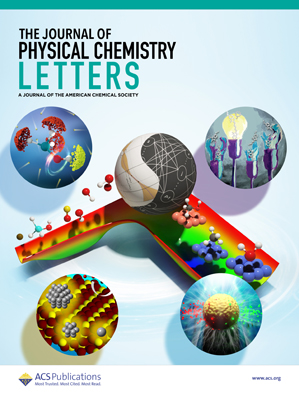可见光-近红外时间分辨吸收光谱研究叶绿素a和b的q波段能量和弛豫
IF 4.8
2区 化学
Q2 CHEMISTRY, PHYSICAL
引用次数: 0
摘要
叶绿素(Chl)是含氧光合生物最丰富的光收集色素;然而,其 Q 波段的能量学和弛豫动力学仍不清楚。在这项工作中,我们对稀释的吡啶溶液中的叶绿素 a 和叶绿素 b 在其 Q 波段内的选择性光激发下进行了 430-1,700 纳米波长的飞秒时间分辨吸收光谱分析。结果发现,在 930-1,700 纳米波长范围内,Bx,y ← Qy 和 Bx,y ← Qx 转变具有明显的近红外吸收特征,这些特征与 400-700 纳米波长范围内的稳态吸收共同揭示了 Chls a 和 b 的 Qx(0,0)-state 能量,它们分别比 Qy(0,0)-state 高出 1,000 ± 400 和 600 ± 400 cm-1。此外,Chls a 和 b 的 Qx 到 Qy 内部转换时间常数估计小于 80 fs。这些发现可能有助于了解 Chls 在光合作用的初级激发能量转移反应中的作用。本文章由计算机程序翻译,如有差异,请以英文原文为准。

The Q-Band Energetics and Relaxation of Chlorophylls a and b as Revealed by Visible-to-Near Infrared Time-Resolved Absorption Spectroscopy
Chlorophyll (Chl) is the most abundant light-harvesting pigment of oxygenic photosynthetic organisms; however, the Q-band energetics and relaxation dynamics remain unclear. In this work, we have applied femtosecond time-resolved (fs-TA) absorption spectroscopy in 430–1,700 nm to Chls a and b in diluted pyridine solutions under selective optical excitation within their Q-bands. The results revealed distinct near-infrared absorption features of the Bx,y ← Qy and Bx,y ← Qx transitions in 930–1,700 nm, which together with the steady-state absorption in 400–700 nm unveiled the Qx(0,0)-state energy that lies 1,000 ± 400 and 600 ± 400 cm–1 above the Qy(0,0)-state for Chls a and b, respectively. In addition, the Qx-to-Qy internal conversion time constants are estimated to be less than 80 fs for Chls a and b. These findings may shed light on understanding the roles of the Chls in the primary excitation energy transfer reactions of photosynthesis.
求助全文
通过发布文献求助,成功后即可免费获取论文全文。
去求助
来源期刊

The Journal of Physical Chemistry Letters
CHEMISTRY, PHYSICAL-NANOSCIENCE & NANOTECHNOLOGY
CiteScore
9.60
自引率
7.00%
发文量
1519
审稿时长
1.6 months
期刊介绍:
The Journal of Physical Chemistry (JPC) Letters is devoted to reporting new and original experimental and theoretical basic research of interest to physical chemists, biophysical chemists, chemical physicists, physicists, material scientists, and engineers. An important criterion for acceptance is that the paper reports a significant scientific advance and/or physical insight such that rapid publication is essential. Two issues of JPC Letters are published each month.
 求助内容:
求助内容: 应助结果提醒方式:
应助结果提醒方式:


